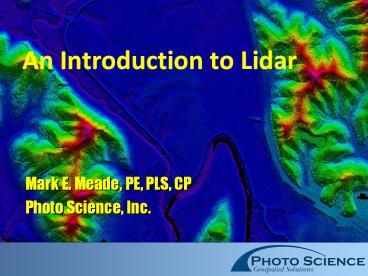An Introduction to Lidar - PowerPoint PPT Presentation
Title:
An Introduction to Lidar
Description:
Knowledge of the planners, operators, office staff. Flying height ... LIDAR and the software we use in processing will continue to improve with time ... – PowerPoint PPT presentation
Number of Views:505
Avg rating:3.0/5.0
Title: An Introduction to Lidar
1
An Introduction to Lidar
Mark E. Meade, PE, PLS, CP Photo Science, Inc.
2
Presentation Outline
- LIDAR Data Capture
- Advantages of Lidar
- Technology Basics
- Intensity and Multiple Returns
- Lidar Accuracy
3
Lidar Data Acquisition
4
(No Transcript)
5
(No Transcript)
6
Advantages of LiDAR Technology
- Provides a highly accurate means of elevation
model collection for 1 or 2 contours - Acquisition can take place day or night shadows
that are problematic in mountainous areas are not
an issue with LiDAR - Unlike photography, acquisition can take place
below cloud cover cloud shadows no issue - Very cost effective for larger projects
- Does not provide break lines, nor is it imagery
7
Why is This Technology Exciting
Time to Collect 1 Million Points
- Conventional Surveying 15.5 years
- Photogrammetry 1.5 years
- Lidar 6.7 seconds _at_ 150 kHz
Costs can be significantly less for the right
projects
8
(No Transcript)
9
Aircraft Requirements
- Flying heights from 3,000 to 6,000
- feet
- Speeds ranging from 90 to 130 knots
- Ability to carry equipment, personnel,
- and full fuel load
10
Point Spacing in Lidar
11
What it is not
- Photography
- We can shade the elevation and intensity data to
create imagery - Doesnt capture breaklines
- Doesnt capture planimetric features
- Advances in software may allow automatic feature
extraction soon
12
Shading by Elevation
13
(No Transcript)
14
(No Transcript)
15
Urban LiDAR Layout
16
(No Transcript)
17
(No Transcript)
18
Veterans Boulevard KTC
- 4 mile long, two lane roadway in Bowling Green,
Kentucky - DMC flight at 2,000 feet for breakline and
planimetric mapping, and digital orthophotos - Lidar flight 3,000 AMT, 90 knots, laser rate of
42.8 kHz, 20 degree FOV - Total of 31 QA/QC points
- RMSE 8.7 cm or 0.28 feet
19
North Dakota Lidar FHWA
- 64 Lidar flight line miles
- 3 Sites
- Teddy Roosevelt National Park and Des Lacs
National Wildlife Refuge - All surveys and QA/QC points provided by FHWA
- 10 QA/QC points
- RMSE of 4.3 cm or 0.14 feet
20
Issues with LIDAR Data
- LIDAR is indiscriminate it places elevation
points on everything. This includes cars,
houses, trees, etc. - LIDAR only places mass points, or random xyz
points. It does NOT pick up breaklines, or lines
of abrupt change in the ground elevation - LIDAR is NOT imagery. LIDAR data can be shaded,
however, to offer a relief image
21
Bare Earth Model
- Significant editing must be employed to create a
Bare Earth Model which models the natural
ground - Some automated procedures may be used. Imagery
backdrop may be necessary - The 80/20 rule applies here as well
- In some cases, traditional photogrammetry may be
necessary to add breaklines
22
(No Transcript)
23
(No Transcript)
24
Intensity and Multiple Returns
- Most units today have the ability to measure
multiple returns and the intensity of the
returned signal for each - This enables specialized applications using the
LIDAR data
25
Multiple LIDAR Returns
26
(No Transcript)
27
Cincinnati Airport Aerial Photo
28
Cincinnati Airport Intensity Plot
29
Lidar Returns and Cloud Cover
30
LIDAR Applications
- LIDAR has significant fixed cost but can be very
cost effective for large projects - Appropriate for a wide range of projects
including forestry, corridor studies, obstruction
mapping, flood studies, city/county mapping, and
transportation projects - Required accuracy must be carefully evaluated
31
Value of Noise in the Data
32
(No Transcript)
33
(No Transcript)
34
LiDAR Accuracy
- Quality of the hardware and software
- Knowledge of the planners, operators, office
staff - Flying height
- Scan angle (also important for vegetation
penetration) - GPS configuration (PDOP and Number of SVs)
- Distance from base station to aerial platform
- Laser power
- Laser rep rate
35
Georgetown, KY Computed 1/12/05
36
(No Transcript)
37
LIDAR Accuracy
- Accuracy of elevation in range of 6 to 30
centimeters (0.20 to 0.98 feet) - Accuracy of XY position in range of 10 to 46
centimeters (0.33 to 1.51 feet) - Accuracy depends on pulse rate, flying height,
GPS configuration, location of ground stations,
and position of the scanner with respect to nadir
38
(No Transcript)
39
(No Transcript)
40
(No Transcript)
41
(No Transcript)
42
Hardware Software Capabilities
2008 167 kHz
2004 100 kHz
1999 25 kHz
Hardware Software
1993 2 kHz
1995 Multiple Returns
2007
1993
43
Where Do We Go from Here?
- Accuracy
- Software Processing
- Automated Feature Classification
- Building Footprints
- Roof Types
- Pervious/Impervious
- Vegetation
- Data Fusion
44
LIDAR Summary
- Simply another tool in our toolbox
- It is not right for every project, but it can
provide substantial cost savings for the right
project - Large-scale, high-accuracy projects still require
conventional mapping solution - LIDAR and the software we use in processing will
continue to improve with time
45
- USGS DEM Lidar DEM
46
Questions?































